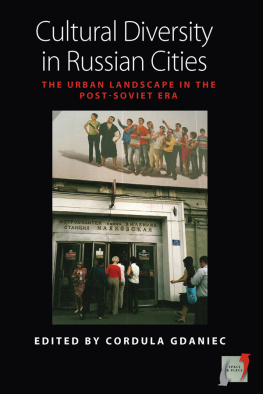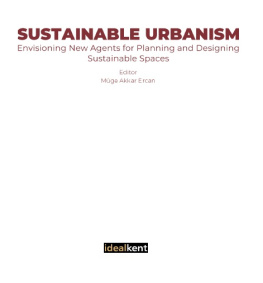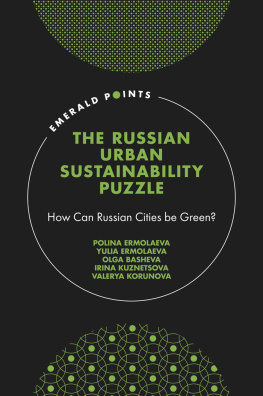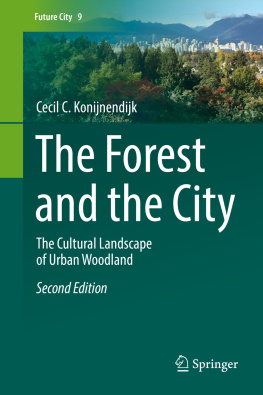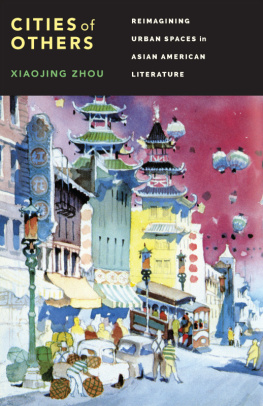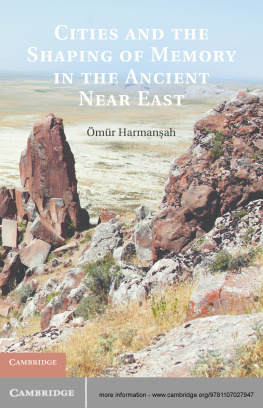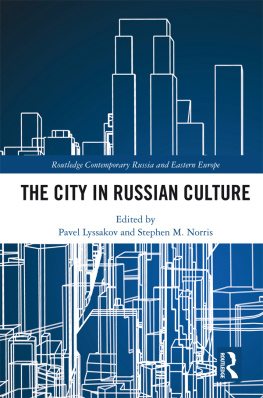Space and Place
Bodily, geographic, and architectural sites are embedded with cultural knowledge and social value. The Anthropology of Space and Place series provides ethnographically rich analyses of the cultural organization and meanings of these sites of space, architecture, landscape, and places of the body. Contributions to this series will examine the symbolic meanings of space and place, the cultural and historical processes involved in their construction and contestation, and how they are in dialogue with wider political, religious, social, and economic institutions.
Volume 1
Berlin, Alexanderplatz: Transforming Place in a Unified Germany
Gisa Weszkalnys
Volume 2
Cultural Diversity in Russian Cities: The Urban Landscape in the post-Soviet Era
Edited by Cordula Gdaniec
CULTURAL DIVERSITY IN RUSSIAN CITIES
The Urban Landscape in the post-Soviet Era
Edited by
Cordula Gdaniec
First published in 2010 by
Berghahn Books
www.berghahnbooks.com
2010 Cordula Gdaniec
All rights reserved. Except for the quotation of short passages for the purposes of criticism and review, no part of this book may be reproduced in any form or by any means, electronic or mechanical, including photocopying, recording, or any information storage and retrieval system now known or to be invented, without written permission of the publisher.
Library of Congress Cataloging-in-Publication Data
Cultural diversity in Russian cities : the urban landscape in the post-Soviet era / edited by Cordula Gdaniec.
p. cm.
Includes bibliographical references and index.
ISBN 978-1-84545-665-8 (hardback : alk. paper)
1. Cultural pluralismRussia (Federation)History. 2. ImperialismSocial aspectsRussia (Federation)History. 3. Rationalization (Psychology)Political aspectsRussia (Federation)History. 4. Language and cultureRussia (Federation) I. Gdaniec, Cordula.
JN6581.C85 2010
304.800947'091732--dc22
2010007450
British Library Cataloguing in Publication Data
A catalogue record for this book is available from the British Library
Printed in the United States on acid-free paper.
ISBN: 978-1-84545-665-8 Hardback
PREFACE AND ACKNOWLEDGEMENTS
This book is a result of activities within a four-year research project based at Humboldt University Berlin funded by the German Research Foundation, DFG. Under the title Urban culture and ethnic representation: Berlin and Moscow as emerging world cities my colleague Alexa Frber and I endeavoured to research various aspects of urban culture in two capitals during a process of transformation since the fall of the Berlin Wall and the collapse of the Soviet Union respectively. Both can be regarded, and in fact present themselves, as world cities but this status has different connotations in each city with respect to the weighting of the role of culture and cultural production vis--vis the economy and politics. We examined different facets of urban culture in connection with ethnic representation in the metropolis of late modernity. In particular we looked at how cultural production and ethnic representation are being instrumentalised in discursive strategies on the level of urban policy and city marketing, how cultural production plays an increasing role within the economy in forming niches for small and micro businesses especially for cultural groups outside the social urban mainstream, and how cultural production opens up spaces of participation in and identification with the city.
The project included several workshops and cooperation with other researchers, as well as with practitioners and artists from different countries. One of these workshops, Public/private spaces an urban culture of diversity?, which we organised in Moscow at the Russian State University for the Humanities (RGGU), served as starting point for this volume. A number of ethnographic case studies of cultural practices from Moscow and Berlin were presented, some of which appear here. As the book took shape over the following years, more contributors joined us at a later stage.
The research project and, by extension, this book project has greatly benefited from the cooperation in particular with the RGGU as our Moscow base, with the researchers at REGION Research Centre in Ulyanovsk and with the researchers at the Centre for Independent Social Research in St. Petersburg. Organising workshops is one thing, but putting together an edited book quite another. I am indebted to Anika Keinz for her great editorial assistance and her encouragement to see this book project through to the end. Working together with the authors has been a valuable experience and I am thankful that they contributed their interesting case studies. I am also grateful to Graham Stack for his translation work and to the copy editors at Berghahn Books for polishing the manuscript. And, last but not least, I would like to thank Alexa Frber for her inspiring collegiality over the course of the project and since, as well as Wolfgang Kaschuba as project leader for his support.
1
Cultural Diversity between Staging and the Everyday
Experiences from Moscow, St. Petersburg and Other Russian Cities. An Introduction
CORDULA GDANIEC
A poster depicting flowers but, interestingly, not people and bearing the caption the city consists of different people (gorod edinstvo nepokhozhikh) can be seen in every Moscow metro station. The original Aristotle quote continues similar people cannot form a city. This implies that urban culture is necessarily diverse, multi-faceted, often contradictory, even conflicting. Cities are built on and develop through cultural diversity. More specifically, this poster indicates a unique situation in Moscow where, as the mayor quotes on the website of the House of Nationalities, diversity is our wealth and beauty, and not a problem in Russian cities and that also constitutes a global form of cosmopolitanism (Evans/Foord 2006). At many intersections of the urban landscape with its temporal axes these three levels, of course, merge or overlap, and cultural diversity is socially produced, implicitly, or even as part of the city's image strategy, by actors from the various groups of interest. Still, in every city there remains a discrepancy between an official rhetoric embracing on the one hand cultural diversity as cultural capital for the city and social capital for its inhabitants, and on the other hand the everyday experience of exclusion and racism or homophobia by the people embodying diversity. In Russian cities today this discrepancy appears to be greater compared to Soviet times and different in its causes and manifestations in comparison with cities in western Europe. However, many trends are rooted in current global flows and transformations, highlighting emerging similarities.
Diversity as Cultural Capital
Every city manages its intrinsic ethnic and cultural mix in a different way. While all cities are spatial and cultural manifestations of their multicultural society, representing a heterogeneous urban landscape as well as multiculturalism or cultural-diversity politics, some actively foster this cultural capital on several levels. With respect to the policy terms (and tools) diversity management and diversity mainstreaming (Fager 2006; Jung 2003), managing cultural diversity, in the context of this introduction, plays out on three levels: 1) that of city government and policy as well as public discourse facilitated by economic agents, state-run or private media; 2) that of organisations representing, or claiming to do so, ethnic or cultural minority groups; and 3) that of everyday social, economic or cultural practices. In Berlin, for instance, cultural diversity plays a central role in city marketing, in urban policy and in people's choice to either move to or visit Berlin (Frber 2005). The city authority's self-representation as an attractive business location and tourist spot, or the events listings (see

